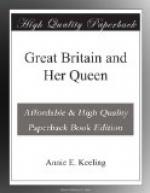The cousins had already met, in 1836, when their mutual attraction had been sufficiently strong; and in 1839, when Prince Albert, with his elder brother Ernest, was again visiting England, the impression already produced became ineffaceably deep. The Queen, whom her great rank compelled to take the initiative, was not very long in making up her mind when and how to act. Her favoured suitor himself, writing to a dear relative, relates how she performed the trying task, inviting him to render her intensely happy by making “the sacrifice of sharing her life with her, for she said she looked on it as a sacrifice. The joyous openness with which she told me this enchanted me, and I was quite carried away by it.” This was on October 15th; nearly six weeks after, on November 23rd, she made to her assembled Privy Council the formal declaration of her intended marriage. There is something particularly touching in even the driest description of this scene; the betrothed bride wearing a simple morning dress, having on her arm a bracelet containing Prince Albert’s portrait, which helped to give her courage; her voice, as she read the declaration clear, sweet, and penetrating as ever, but her hands trembling so excessively that it was surprising she could read the paper she held. It was a trying task, but not so difficult as that which had devolved on her a short time before, when, in virtue of her sovereign rank, she had first to speak the words of fate that bound her to her suitor.
[Illustration: Prince Albert.]
Endowed with every charm of person, mind, and manner that can win and keep affection, Prince Albert was able, in marrying the Queen, who loved him and whom he loved, to secure for her a happiness rare in any rank, rarest of all on the cold heights of royalty. This was not all; he was the worthy partner of her greatness. Himself highly cultivated in every sense, he watched with keenest interest over the advance of all cultivation in the land of his adoption, and identified himself with every movement to improve its condition. His was the soul of a statesman—wide, lofty, far-seeing, patient; surveying all great things, disdaining no small things, but with tireless industry pursuing after all necessary knowledge. Add to these intellectual excellences the moral graces of ideal purity of life, chivalrous faithfulness of heart, magnanimous self-suppression, and fervent piety, and we have a slight outline of a character which, in the order of Providence, acted very strongly and with a still living force on the destinies of nineteenth-century England. The Queen had good reasons for the feeling of “confidence and comfort” that shone in the glance she turned on her bridegroom as they walked away, man and wife at last, from the altar of the Chapel Royal, on February 10th, 1840. The union she then entered into immeasurably enhanced her popularity, and strengthened her position as surely as it expanded her nature. Not many years elapsed before Sir Robert Peel could tell her that, in spite of the inroads of democracy, the monarchy had never been safer, nor had any sovereign been so beloved, because “the Queen’s domestic life was so happy, and its example so good.” Only the Searcher of hearts knoweth how great has been the holy power of a pure, fair, and noble example constantly shining in the high places of the land.




